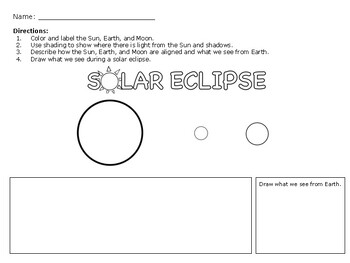Solar and Lunar Eclipse
Science for the Everyday
0 Followers
Grade Levels
1st - 6th
Subjects
Resource Type
Standards
NGSS1-ESS1-1
NGSS5-ESS1-2
NGSS5-ESS1-1
NGSS4-ESS1-1
NGSSMS-ESS1-2
Formats Included
- PDF
Pages
3 pages
Science for the Everyday
0 Followers
Description
Have students show what they know about solar and lunar eclipses. Students can have an opportunity to draw and write about how different eclipses occur. This pairs best with a video, book, or my other activity- Reading Passage and Share Eclipse.
Total Pages
3 pages
Answer Key
N/A
Teaching Duration
30 minutes
Report this resource to TPT
Reported resources will be reviewed by our team. Report this resource to let us know if this resource violates TPT’s content guidelines.
Standards
to see state-specific standards (only available in the US).
NGSS1-ESS1-1
Use observations of the sun, moon, and stars to describe patterns that can be predicted. Examples of patterns could include that the sun and moon appear to rise in one part of the sky, move across the sky, and set; and stars other than our sun are visible at night but not during the day. Assessment of star patterns is limited to stars being seen at night and not during the day.
NGSS5-ESS1-2
Represent data in graphical displays to reveal patterns of daily changes in length and direction of shadows, day and night, and the seasonal appearance of some stars in the night sky. Examples of patterns could include the position and motion of Earth with respect to the sun and selected stars that are visible only in particular months. Assessment does not include causes of seasons.
NGSS5-ESS1-1
Support an argument that differences in the apparent brightness of the sun compared to other stars is due to their relative distances from Earth. Assessment is limited to relative distances, not sizes, of stars. Assessment does not include other factors that affect apparent brightness (such as stellar masses, age, stage).
NGSS4-ESS1-1
Identify evidence from patterns in rock formations and fossils in rock layers to support an explanation for changes in a landscape over time. Examples of evidence from patterns could include rock layers with marine shell fossils above rock layers with plant fossils and no shells, indicating a change from land to water over time; and, a canyon with different rock layers in the walls and a river in the bottom, indicating that over time a river cut through the rock. Assessment does not include specific knowledge of the mechanism of rock formation or memorization of specific rock formations and layers. Assessment is limited to relative time.
NGSSMS-ESS1-2
Develop and use a model to describe the role of gravity in the motions within galaxies and the solar system. Emphasis for the model is on gravity as the force that holds together the solar system and Milky Way galaxy and controls orbital motions within them. Examples of models can be physical (such as the analogy of distance along a football field or computer visualizations of elliptical orbits) or conceptual (such as mathematical proportions relative to the size of familiar objects such as students’ school or state). Assessment does not include Kepler’s Laws of orbital motion or the apparent retrograde motion of the planets as viewed from Earth.




